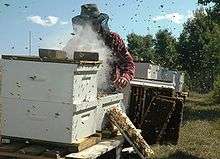Pest (organism)
A pest is any animal or plant detrimental to humans or human concerns, including crops, livestock and forestry, among others. The term is also used of organisms that cause a nuisance, such as in the home. An older usage is of a deadly epidemic disease, specifically plague. In its broadest sense, a pest is a competitor of humanity.[1]
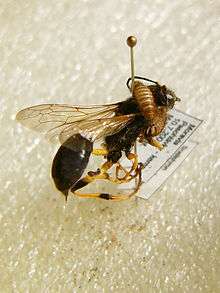
Concept
147.jpg)
A pest is any living organism, whether animal, plant or fungus, which is invasive or troublesome to plants or animals, human or human concerns, livestock, or human structures. It is a loose concept, as an organism can be a pest in one setting but beneficial, domesticated or acceptable in another. Micro-organisms, whether bacteria, microscopic fungi, protista, or viruses that cause trouble, on the other hand, are generally thought of as causes of disease (pathogens) rather than as pests.[2]
Animals as pests
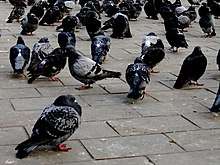
Animals are considered pests or vermin when they damage crops, forestry, or buildings or injure people. Elephants are regarded as pests by the farmers whose crops they raid and trample. Mosquitoes and ticks are vectors that can transmit diseases, but are also pests because of the distress caused by their bites. Grasshoppers are usually solitary herbivores of little economic importance until the conditions are met for them to enter a swarming phase, become locusts and cause enormous damage.[3] Many people appreciate birds in the countryside and their gardens, but when these accumulate in large masses, they can be a nuisance. Flocks of starlings can consist of hundreds of thousands of individual birds, their roosts can be noisy and their droppings voluminous; the droppings are acidic and can cause corrosion of metals, stonework and brickwork as well as being unsightly. Pigeons in urban settings may be a health hazard, and gulls near the coast can become a nuisance, especially if they become bold enough to snatch food from passers-by. All birds are a risk at airfields where they can be sucked into aircraft engines.[4] Woodpeckers sometimes excavate holes in buildings, fencing and utility poles, causing structural damage;[5] they also drum on various reverberatory structures on buildings such as gutters, downspouts, chimneys, vents and aluminium sheeting.[6] Jellyfish can form vast swarms which may be responsible for damage to fishing gear, and sometimes clog the cooling systems of power and desalination plants which draw their water from the sea.[7]
Many of the animals that we regard as pests live in our homes. Before humans built dwellings, these creatures lived in the wider environment, but co-evolved with humans, adapting to the warm, sheltered conditions that a house provides, the wooden timbers, the furnishings, the food supplies and the rubbish dumps. Many no longer exist as free-living organisms in the outside world, and can therefore be considered to be domesticated.[8] The St Kilda house mouse rapidly became extinct when the last islander left the island of St Kilda, Scotland in 1930, but the St Kilda field mouse survived.[9]
Plants as pests
Plants may be considered pests, for example if they are invasive species. There is no universal definition of what makes a plant a pest. Some governments, such as that of Western Australia, permit their authorities to prescribe as a pest plant "any plant that, in the local government authority's opinion, is likely to adversely affect the environment of the district, the value of property in the district, or the health, comfort or convenience of the district’s inhabitants."[11] An example of such a plant prescribed under this regulation is caltrop, Tribulus terrestris, which can cause poisoning in sheep and goats, but is mainly a nuisance around buildings, roadsides and recreation areas because of its uncomfortably sharp spiny burrs.[10]
Ecology
The term "plant pest", mainly applied to insect micropredators of plants, has a specific definition in terms of the International Plant Protection Convention and phytosanitary measures worldwide. A pest is any species, strain or biotype of plant, animal, or pathogenic agent injurious to plants or plant products.[12]
Plant defences against pests
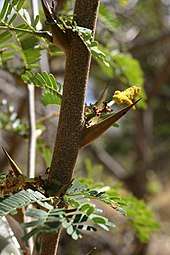
Plants have developed strategies that they use in their own defence, be they thorns (modified stems) or spines (modified leaves), stings, a thick cuticle or waxy deposits, with a second line of defence being toxic or distasteful secondary metabolites. Mechanical injury to the plant tissues allows entry of pathogens and stimulates the plant to mobilise its chemical defences. The plant soon seals off the wound to reduce further damage.[13]
Plants sometimes take active steps to reduce herbivory. Macaranga triloba for example has adapted its thin-walled stems to create ideal housing for an ant Crematogaster spp., which, in turn, protects the plant from herbivores. In addition to providing housing, the plant also provides the ant with its exclusive food source in the form of food bodies located on the leaf stipules.[14] Similarly, several Acacia tree species have developed stout spines that are swollen at the base, forming a hollow structure that provides housing for ants which protect the plant. These Acacia trees also produce nectar in nectaries on their leaves as food for the ants.[15]
Economic impact
In agriculture and horticulture

The animal groups of greatest importance as pests (in order of economic importance) are insects, mites, nematodes and gastropod molluscs.[16][17]
Insects are responsible for two major forms of damage to crops. First there is the direct injury they cause to the plants as they feed on the tissues; a reduction in leaf surface available for photosynthesis, distortion of growing shoots, a diminution of the plant's growth and vigour, and the wilting of shoots and branches caused by the insects' tunnelling activities. Secondly there is the indirect damage, where the insects do little direct harm, but either transmit or allow entry of fungal, bacterial or viral infections.[18] Although some insects are polyphagous, many are restricted to one specific crop, or group of crops. In many cases it is the larva that feed on the plants, building up a nutritional store that will be used by the short-lived adult; sawfly and lepidopteran larvae feed mainly on the aerial portions of plants while beetle larvae tend to live underground, feeding on roots, of tunnel into the stem or under the bark. The true bugs, Hemiptera, have piercing and sucking mouthparts and live by sucking sap from plants. These include aphids, whiteflies and scale insects. Apart from weakening the plant, they encourage the growth of sooty mould on the honeydew the insects produce, which cuts out the light and reduces the plant's growth. They often transmit serious viral diseases between plants.[19]
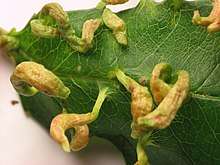
The mites that cause most trouble in the field are the spider mites. These are less than 1 mm (0.04 in) in diameter, can be very numerous, and thrive in hot, dry conditions. They mostly live on the underside of leaves and puncture the plant cells to feed, with some species forming webbing. They occur on nearly all important food crops and ornamental plants, both outdoors and under glass, and include some of the most economically important pests.[20] Another important group of mites is the gall mites which affect a wide range of plants, several species being major pests causing substantial economic damage to crops. They can feed on the roots or the aerial parts of plants and transmit viruses.[21] Some examples are the big bud mite that transmits the reversion virus of blackcurrants,[22] the coconut mite which can devastate coconut production,[23] and the cereal rust mite which transmits several grass and cereal viruses.[24] Being exceedingly minute, many plant mites are spread by wind, although others use insects or other arthropods as a means to disperse.[21]
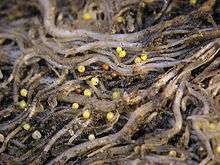
The nematodes (eelworms) that attack plants are minute, often too small to be seen with the naked eye, but their presence is often apparent in the galls or "knots" they form in plant tissues. Vast numbers of nematodes are found in soil and attack roots, but others affect stems, buds, leaves, flowers and fruits. High infestations cause stunting, deformation and retardation of plant growth, and the nematodes can transmit virus diseases from one plant to another.[25] When its populations are high, the potato cyst nematode can cause reductions of 80% in yield of susceptible potato varieties.[26] The nematode eggs survive in the soil for many years, being stimulated to hatch by chemical cues produced by roots of susceptible plants.[27]
Slugs and snails are terrestrial gastropod molluscs which typically chew leaves, stems, flowers, fruit and vegetable debris. Slugs differ from snails in having shells that are too small for the animal to retract inside; the shell-less state has evolved on multiple occasions during the evolutionary development of molluscs, so there is little taxonomic difference between the two, and both slugs and snails do considerable damage to plants. With novel crops being grown and with insect pests having been brought more under control by biological and other means, the damage done by molluscs becomes of greater significance.[28] Terrestrial molluscs need moist environments; snails may be more noticeable because their shells provide protection from dessication, while most slugs live in soil and only come out to feed at night. They devour seedlings, damage developing shoots and feed on salad crops and cabbages, and some species tunnel into potatoes and other tubers.[29]
Weeds
.jpg)
A weed is a plant considered undesirable in a particular situation; the term has no botanical significance. Often, weeds are simply those native plants that are adapted to grow in disturbed ground, the disturbance caused by ploughing and cultivation favouring them over other species. Any plant is a weed if it appears in a location where it is unwanted; Bermuda grass makes a good lawn plant under hot dry conditions but become a bad weed when it out-competes cultivated plants.[31]
A different group of weeds consists of those that are invasive, introduced, often unintentionally, to habitats to which they are not native but in which they thrive. Without their original competitors, herbivores, and diseases, they may increase and become a serious nuisance.[32] One such plant is purple loosestrife, a native of Europe and Asia where it occurs in ditches, wet meadows and marshes; introduced into North America, it has no natural enemies to keep it in check, and has taken over vast tracts of wetlands to the exclusion of native species.[33]
In forestry
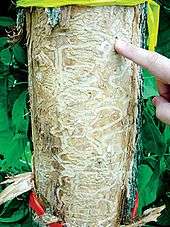
In forestry, pests may affect various parts of the tree, from its roots and trunk to the canopy far overhead. The accessibility of the part of the tree affected may make detection difficult, so that a pest problem may already be far advanced before it is first observed from the ground. The larch sawfly and spruce budworm are two insect pests prevalent in Alaska and aerial surveys can show which sections of forest are being defoliated in any given year so that appropriate remedial action can be taken.[34]
Some pests may not be present on the tree all year round, either because of their life cycle or because they rotate between different host species at different times of year.[35] The larvae of wood-boring beetles may spend years excavating tunnels under the bark of trees, and only emerge into the open for brief periods as adults, to mate and disperse. The import and export of timber has inadvertently assisted some insect pests to establish themselves far from their country of origin. An insect may be of little importance in its native range, being kept under control by parasitoid wasps, predators and the natural resistance of the host trees, but be a serious pest in a region into which it has been introduced.[36] This is the case with the emerald ash borer, an insect native to north-eastern Asia, which, since its arrival in North America, has killed millions of ash trees.[37]
In buildings
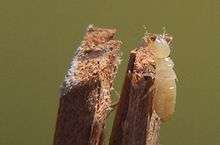
Animals able to live in the dry conditions found in buildings include many arthropods such as beetles, cockroaches, moths, and mites. Termites, woodworm, longhorn beetles, and wood ants cause structural damage to buildings and furniture.[38]
There are over four thousand species of cockroach worldwide, but only four species are commonly regarded as pests, having adapted to live permanently in buildings.[39] Considered to be a sign of insanitary conditions, they feed on almost anything, reproduce rapidly and are difficult to eradicate. They can passively transport pathogenic microbes on their body surfaces, particularly in environments such as hospitals,[40] and are linked with allergic reactions in humans.[41]
Carpet beetles and clothes moths cause non-structural damage to property such as clothing and carpets.[42][43] It is the larvae that are destructive, feeding on wool, hair, fur, feathers and down. The moth larvae live where they feed, but the beetle larvae may hide behind skirting boards or in other similar locations between meals. They may be introduced to the home in any product containing animal fibres including upholstered furniture; the moths are feeble fliers but the carpet beetles may also enter houses through open windows.[44]
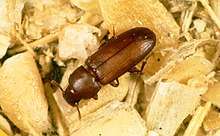
Various insects attack dry food products, with flour beetles, the drugstore beetle, the sawtoothed grain beetle and the Indianmeal moth being found worldwide. The insects may be present in the warehouse or may be introduced during shipping, in retail outlets or in the home; they may enter packets through tiny cracks or may chew holes in the packaging. The longer a product is stored, the more likely it is to become contaminated, with the insects often originating from dry pet foods.[45]
Some mites, too, infest foodstuffs and other stored products. Each substance has its own specific mite, and they multiply with great rapidity. One of the most damaging is the flour mite, which is found in grain and may become exceedingly abundant in poorly stored material. In time, predatory mites usually move in and control the flour mites.[46]
Countermeasures
Pest control in agriculture and horticulture
The control of pests in crops is as old as civilisation. The earliest approach was mechanical, from ploughing to picking off insects by hand. Early methods included the use of sulphur compounds, before 2500 BC in Sumeria. In ancient China, insecticides derived from plants were in use by 1200 BC to treat seeds and to fumigate plants. Chinese agronomy recognised biological control by natural enemies of pests and the varying of planting time to reduce pests before the first century AD. The agricultural revolution in Europe saw the introduction of effective plant-based insecticides such as pyrethrum, derris, quassia, and tobacco extract. The phylloxera (a powdery mildew) damage to the wine industry in the 19th century resulted in the development of resistant varieties and grafting, and the accidental discovery of effective chemical pesticides, Bordeaux mixture (lime and copper sulphate) and Paris Green (an arsenic compound), both very widely used. Biological control also became established as an effective measure in the second half of the 19th century, starting with the vedalia beetle against cottony cushion scale. All these methods have been refined and developed since their discovery.[47]
Pest control in forestry
Forest pests inflict costly damage, but treating them is often unaffordable, given the relatively low value of forest products compared to agricultural crops. It is also generally impossible to eradicate forest pests, given the difficulty of examining entire trees, and the certainty that pesticides would damage many forest organisms other than the intended pests. Forest integrated pest management therefore aims to use a combination of prevention, cultural control measures, and direct control (such as pesticide use). Cultural measures include choosing appropriate species, keeping competing vegetation under control, ensuring a suitable stocking density, and minimizing injury and stress to trees.[48]
Pest control in buildings
Pest control in buildings can be approached in several ways, such as improving sanitation and garbage control, modifying the habitat, and using repellents, growth regulators, traps, baits and pesticides.[49]
in mythology, religion, folklore and culture
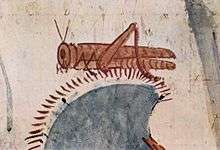
Pests have attracted human attention from the birth of civilisation. Plagues of locusts caused devastation in the ancient Middle East, and were recorded in tombs in Ancient Egypt from as early as 2470 BC, and in the Book of Exodus in the Bible, as taking place in Egypt around 1446 BC.[50][51] Homer's Iliad mentions locusts taking to the wing to escape fire.[52]
The 10th century Greek monk Tryphon of Constantinople is said to have prayed "Snails, earwigs and all other creatures, hurt not the vines, nor the land nor the fruit of the trees, nor the vegetables ... but depart into the wild mountains." Unfortunately, this prayer proved ineffective, and pests continue to ravage the land.[28]
References
- Merriam-Webster dictionary, accessed 22 August 2012.
- "Frequently asked questions from Crop Protection Unit" (PDF). Agriculture and Agrifood Department, Ministry of Primary Resources and Tourism, Brunei. Retrieved 7 April 2020.
- van Emden, H. F.; Service, M. W. (2004). Pest and Vector Control. Cambridge University Press. pp. 8–11. ISBN 978-0-521-01083-2.
- "PestAware". BPCA. Retrieved 2 April 2020.
- "Stopping Woodpecker Damage". Joy of Birds. 22 March 2018. Retrieved 3 April 2020.
- "Three Reasons Why Woodpeckers Drill Holes on Houses". Woodpeckers. Cornell Lab of Ornithology. 2002. Retrieved 3 April 2020.
- Masilamani, J.; Jesudoss, K.; Kanavillil, Nandakumar; Satpathy, K. K.; Nair, K.; Azariah, J. (2000). "Jellyfish ingress: A threat to the smooth operation of coastal power plants". Current Science. 79: 567–569.
- Jones, Richard (2015). House Guests, House Pests: A Natural History of Animals in the Home. Bloomsbury Publishing. p. Preface. ISBN 978-1-4729-0624-3.
- Turner, Robin (March 2002). "People and nature on St Kilda". Retrieved 11 April 2020.
- "Caltrop: what you should know". Government of Western Australia. 1 June 2017. Retrieved 2 April 2020.
- "Prescribing pest plants". Government of Western Australia. 25 October 2017. Retrieved 2 April 2020.
- FAO Corporate Document Repository: Guidelines for Phytosanitary Certificates. Retrieved 1 August 2012
- Walling, L. L. (2000). "The myriad plant responses to herbivores". Journal of Plant Growth Regulation. 19 (2): 195–216. doi:10.1007/s003440000026. PMID 11038228.
- Heil, Martin (1997). Fiala, Brigitte; Linsenmair, K. Eduard; Zotz, Gerhard; Menke, Petra. "Food body production in Macaranga triloba (Euphorbiaceae): A plant investment in anti-herbivore defense via symbiotic ant partners". Journal of Ecology. 85 (6): 847–861. doi:10.2307/2960606. JSTOR 2960606.
- Young, Truman P.; Stubblefield, Cynthia H.; Isbell, Lynne A. (January 1997). "Ants on swollen-thorn acacias: species coexistence in a simple system". Oecologia. 109 (1): 98–107. Bibcode:1997Oecol.109...98Y. doi:10.1007/s004420050063. PMID 28307618.
- Speiser B. (2002). "Chapter 219. Molluscicides". 506–508. doi:10.1201/NOE0824706326.ch219 PDF In: Pimentel D. (ed.) (2002). Encyclopedia of Pest Management. ISBN 978-0-8247-0632-6.
- Stange, L.A. (created September 2004, updated March 2006). "Snails and Slugs of Regulatory Significance to Florida" Archived 2 December 2010 at the Wayback Machine. Division of Plant Industry, Florida Department of Agriculture and Consumer Services. Accessed 27 August 2010.
- Campbell, Neil A.; Reece, Jane B. (2002). Biology (6th ed.). Pearson Education. pp. 661–670. ISBN 978-0-201-75054-6.
- "True bugs (Order: Hemiptera)". Amateur Entomologists' Society. Retrieved 6 April 2020.
- Zhang, Zhi-Qiang (2003). Mites of Greenhouses: Identification, Biology and Control. CABI. p. 47. ISBN 978-0-85199-841-1.
- Jeppson, L.R.; Keifer, Hartford H.; Baker, Edward William (1975). Mites Injurious to Economic Plants. University of California Press. p. 15. ISBN 978-0-520-02381-9.
- Hummer, Kim; Postman, Joseph (2000-03-01). "Black Currant Gall Mite". Currant and Gooseberry Pests. USDA/ARS National Clonal Germplasm Repository. Archived from the original on 2012-09-26. Retrieved 2013-03-09.
- Sharon Angella McDonald (July 9, 1997). Infestation patterns of the coconut mite, Eriophyes guerreronis (Keifer) (Acari: Eriophyidae), on coconuts and resulting yield loss in eastern Jamaica (PDF) (Master of Science thesis). Virginia Polytechnic Institute and State University. Archived from the original (PDF) on 2011-06-08. Retrieved 2009-12-21.
- Skoracka, A (2007). "Reproductive barriers between populations of the cereal rust mite Abacarus hystrix confirm their host specialization". Evolutionary Ecology. 22 (5): 607–616. doi:10.1007/s10682-007-9185-5.
- Palomares-Rius, Juan Emilio (2017). Carolina Escobar; Javier Cabrera; Alessio Vovlas. "Anatomical Alterations in Plant Tissues Induced by Plant-Parasitic Nematodes". Frontiers in Plant Science. 8. doi:10.3389/fpls.2017.01987.
- Evans-Goldner, Lynn. "Pale Cyst Nematode". USDA. APHIS. Retrieved 7 April 2020.
- Decker, Heinz (1989). Plant Nematodes and Their Control: Phytonematology. Brill. pp. 1–9. ISBN 90-04-08922-5.
- Barker, G. M. (2002). Molluscs as Crop Pests. CABI. p. 1. ISBN 978-0-85199-790-2.
- "Slugs and snails". Which?. Retrieved 5 April 2020.
- "Alligator Weed". Texas Invasives. Retrieved 5 April 2020.
- Spencer, Edwin R. (24 July 2013). All About Weeds. Courier Corporation. p. 1. ISBN 978-0-486-14442-9.
- Janick, Jules (1979). Horticultural Science (3rd ed.). W.H. Freeman. p. 308. ISBN 0-7167-1031-5.
- "Non-native Invasive Freshwater Plants - Purple Loosestrife (Lythrum salicaria)". Archived from the original on 7 July 2016. Retrieved 9 April 2020.
- Forest Insect and Disease Conditions in Alaska. U.S. Department of Agriculture, Forest Service, Alaska Region, Division of State and Private Forestry. 1998. pp. 17–22.
- Leather, Simon R. (2008). Insect Sampling in Forest Ecosystems. John Wiley & Sons. p. 4. ISBN 978-1-4051-4029-4.
- Herms, Daniel A.; McCullough, Deborah G. (2013). "Emerald Ash Borer Invasion of North America: History, Biology, Ecology, Impacts, and Management" (PDF). Annual Review of Entomology. 59: 13–30. doi:10.1146/annurev-ento-011613-162051. PMID 24112110.
- "Emerald ash borer". USDA Forest Service. Retrieved 3 April 2020.
- Ghiassi, Bahman; Lourenco, Paulo B. (2018). Long-term Performance and Durability of Masonry Structures: Degradation Mechanisms, Health Monitoring and Service Life Design. Elsevier Science. pp. 314–315. ISBN 978-0-08-102111-8.
- Valles, S.M.; Koehler, P.G.; Brenner, R.J. (1999). "Comparative insecticide susceptibility and detoxification enzyme activities among pestiferous blattodea" (PDF). Comparative Biochemistry and Physiology Part C: Pharmacology, Toxicology and Endocrinology. 124 (3): 227–232. doi:10.1016/S0742-8413(99)00076-6. PMID 10661713.
- Rivault, C.; Cloarec, A.; Guyader, A. Le (1993). "Bacterial load of cockroaches in relation to urban environment". Epidemiology and Infection. 110 (2): 317–325. doi:10.1017/S0950268800068254. PMC 2272268. PMID 8472775.
- Bernton, H.S.; Brown, H. (1964). "Insect Allergy Preliminary Studies of the Cockroach". J. Allergy. 35 (506–513): 506–13. doi:10.1016/0021-8707(64)90082-6. PMID 14226309.
- Koehler, P. G.; Oi, F. M. (1991). "Carpet Beetles". University of Florida IFAS Extension.
- "Understanding Clothes Moth Infestations". English Heritage. Retrieved 8 April 2020.
- United States: Science and Education Administration (1980). Protecting Woolens Against Clothes Moths and Carpet Beetles. Department of Agriculture, Science and Education Administration. pp. 3–8.
- Hui, Y.H.; Bruinsma, L. Bernard; Gorham, J. Richard; Nip, Wai-Kit; Tong, Phillip S.; Ventresca, Phil (2002). Food Plant Sanitation. CRC Press. pp. 426–427. ISBN 978-0-203-91056-6.
- Stored-grain Pests. U.S. Government Printing Office. 1955. pp. 41–42.
- Flint, Mary; van den Bosch, R. (1981). Chapter 4, A History of Pest Control (PDF). Introduction to Integrated Pest Management. Springer. pp. 52–81. ISBN 978-1-4615-9212-9. OCLC 840286794.
- "Pest Management" (PDF). North Carolina Forest Service. Retrieved 8 April 2020.
- Pat O'Connor-Marer (2006). Residential, Industrial, and Institutional Pest Control. UCANR Publications. pp. 2–17. ISBN 978-1-879906-70-9.
- Krall, S.; Peveling, R.; Diallo, B. D. (1997). New Strategies in Locust Control. Springer. pp. 453–454. ISBN 978-3-7643-5442-8.
- Book of Exodus. 10: 13–15.CS1 maint: location (link)
- Homer. "Iliad 21.1". Perseus Tufts. Retrieved 3 April 2020.
Further reading
- Hockings, F. D. 2014,"Pests, Diseases and Beneficials", CSIRO Publishing, Melbourne, ISBN 9781486300211
- Ordish, George (1976). The constant pest : a short history of pests and their control. P. Davies. ISBN 978-0-432-11300-4. OCLC 2276485.
External links



- UF/IFAS Pest Alert Web site - arthropods, nematodes and plant diseases affecting humans, livestock/pets, agricultural and ornamental plants.
